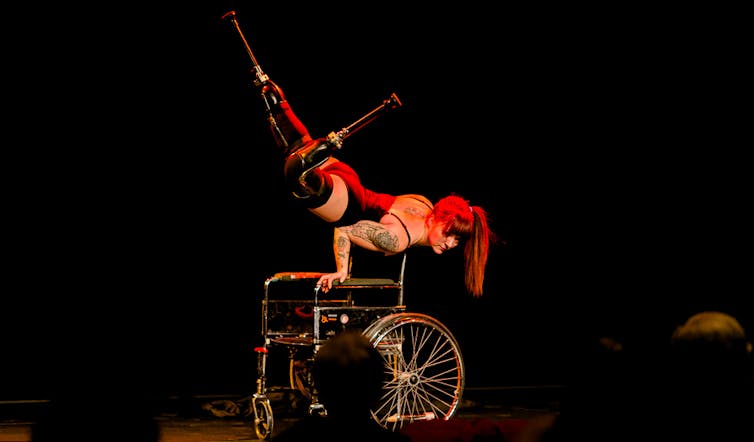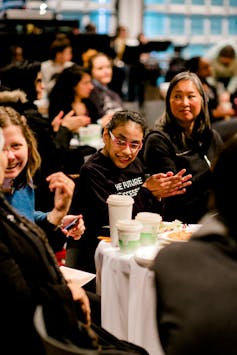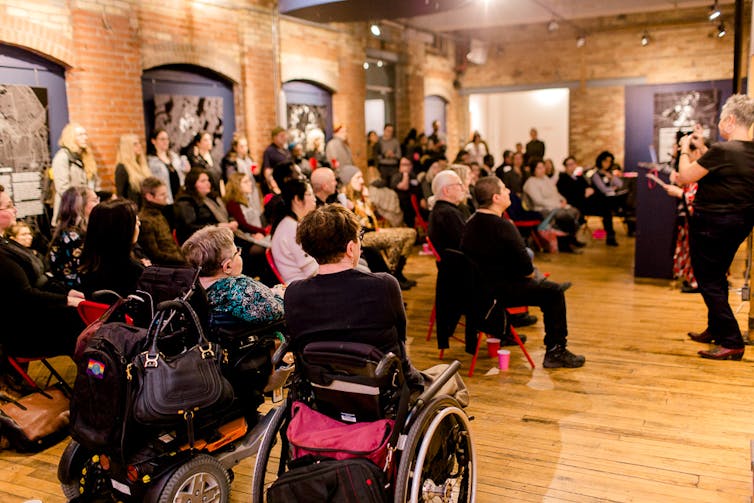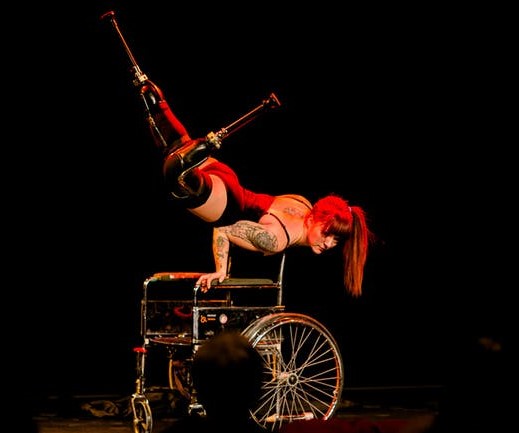
Erin Ball performs at Cripping the Arts at Harbourfront Centre in Toronto, in January 2019. She balances with her hands on the arms of an old wheelchair. Behind her, two long pegs extend from her prosthetic legs. (Michelle Peek Photography for ReVision), Author provided Carla Rice, University of Guelph and Kayla Besse, University of Guelph
Have you ever been nervous about going to the theatre?
Maybe you’re unfamiliar with theatre etiquette, maybe you have children or maybe you find it hard to stay still for hours feeling trapped in your seat. In Shakespeare’s day, theatregoers drank, ate and socialized their way through performance.
There is a more generous way to engage with the arts, and related to this, much to learn from disability arts in particular.
Let bodies be bodies
Relaxed performance — an approach to performance that challenges what have developed as strict expectations and codes for audience and performer engagement and behaviour — is making theatre and other types of live performance like fashion shows and musical events more accessible.
As researchers with our own personal experiences with disability and difference, we are interested in the potential of relaxed performance through our work with the ReVision Centre for Art & Social Justice.
Such performances are designed to serve audiences and performers alike. A relaxed audience space welcomes people to move around, eat, emote or step out to a quiet space if they so desire. Relaxed performance might include dimmer lighting and lowered sound, a pre-show talk to explain what will happen and on-going consultation with disabled people to make sure everyone feels welcome.

Tarik Elmoutawakil of Brownton Abbey performs at Cripping the Arts, Harbourfront Centre, Toronto. (Michelle Peek Photography courtesy of Bodies in Translation: Activist Art, Technology & Access to Life, ReVision: The Centre for Art & Social Justice at the University of Guelph), Author provided
Radical accessibility
Relaxed performance is especially important for those with mental and physical disabilities or differences and those living with a broad range of conditions. Disabled people have historically been excluded from full and meaningful participation in the arts.

Sky Stonefish, centre, and Nadine Changfoot, right, both affiliated with ReVision, are seen in the audience at Cripping the Arts, Harbourfront Centre, Toronto. (Michelle Peek Photography courtesy of Bodies in Translation: Activist Art, Technology & Access to Life, ReVision: The Centre for Art & Social Justice at the University of Guelph), Author provided
The visibility of disabled people itself has had a troubled history: from being hidden away in attics and institutions to being put on display in freak shows, disabled people are rarely invited to be ourselves in public spaces.
In a study we conducted with British Council Canada, we found that most audience members really enjoy relaxed performances and appreciate the greater freedom they offer. Through our conversations with theatre artists and managers, we’ve also found that relaxed performances make space for disability justice in the arts.
One theatre person we spoke to called relaxed performance “the most radical form of accessibility we have now.”
Magic of disabled artists
Relaxed performances go hand-in-hand with the growing field of disability arts.
Sean Lee, curator and director of programming at Tangled Art + Disability in Toronto, shares how disability arts dismantles the notion that art by disabled artists is primarily therapeutic. Rather, as Lee emphasizes, disability art “opens up new ways of understanding aesthetics and experience.”
Disability arts represents a new international wave showcasing the vitality and creativity of people living with difference. From Erin Ball’s circus performances to Alex Bulmer’s blind theatre work, disabled artists are exploding stereotypes about what disabled people can do. The disability arts movement welcomes disability and invites audiences to come closer and re-imagine relationships to difference.
Arts companies, galleries or programs in Canada such as Bodies in Translation, Tangled Arts + Disability, Inside Out Theatre, Kickstart Disability Arts and Culture, SPiLL.PROpagation and more are changing the cultural conversation about what disability art and disability artists look like.
For everyone
Relaxed performances matter to many people living with difference, including those who do and do not identify with the label of “disability.” Beginning in the United Kingdom in the 1990s, relaxed performance emerged out of autistic communities, as a way to reimagine spaces with sensory sensitivities in mind. Soon, theatre professionals saw the advantages of relaxing performances for many groups. A full 20 per cent of theatres in the UK now offer relaxed performances.
Beginning in 2015, the British Council brought relaxed performance to Canada, delivering training on accessible theatre to theatre professionals. Trainings called into question medical models of disability, which see disability as something that needs fixing.

The audience at ‘Through A Tired Eye,’ by Bruce Horak, at Tangled Art + Disability, Toronto. (Michelle Peek Photography courtesy of Bodies in Translation: Activist Art, Technology & Access to Life, ReVision: The Centre for Art & Social Justice at the University of Guelph), Author provided
Relaxed performances borrow from the social model of disability, which views disability as an expression of human diversity, and as part of the story of humanity.
Relaxed spaces include more than just ramps to enter the building. “Access guides” or “visual stories” help audiences know what to expect before they arrive. Some organizations and events in Canada are already producing their own stunning access guides, with plain language glossaries, directions to the event space (with photos), explanations of all the accessibility features that will be in place and more. Others are experimenting with creating their own DIY access guides.
Reaching diverse audiences
A quality relaxed performance doesn’t come together last minute. Accessibility must be thoroughly considered.
For example, what if directors of an upcoming play incorporate sign language interpretation, but marketing hasn’t reached out to Deaf audiences? By making sure to create accessible websites and social media and video invitations for Deaf audiences, arts organisations can demonstrate solidarity with disabled communities.
We are now teaching relaxed performance principles to university students through York University’s theatre department, Ryerson University’s fashion department and the symphonic choir through the University of Guelph’s School of Fine Arts and Music. We are working towards ensuring relaxed performance becomes an integral part of artistic training.
Legislative necessity
Relaxed performances aren’t only a matter of comfort or preference. In June, 2019, Canada passed the Accessible Canada Act. Under this law, government organizations, Crown corporations and government-regulated industries must create accessibility plans, develop feedback tools and consult disabled people. Failure to do so can result in fines up to $250,000.
We anticipate this act is a first step — and that once these measures are embedded in government institutions, they will spread. If art is that which helps society to confront difficult truths and imagine better futures — and we believe it is — then arts organizations will perhaps strive for a higher standard than complying with law.
Artists tend to desire and welcome difference, whether off or on stage. By transforming our cultural spaces and imaginations, we foresee arts organizations creating expansive visions of belonging.
So the next time you’re looking for a night out, choose a relaxed performance. You may be surprised at the ease you feel in a space that welcomes difference.
![]()
Carla Rice, Professor and Canada Research Chair, University of Guelph and Kayla Besse, Disability Arts researcher, ReVision Centre, University of Guelph
This article is republished from The Conversation under a Creative Commons license. Read the original article.
« Voix de la SRC » est une série d’interventions écrites assurées par des membres de la Société royale du Canada. Les articles, rédigés par la nouvelle génération du leadership académique du Canada, apportent un regard opportun sur des sujets d’importance pour les Canadiens. Les opinions présentées sont celles des auteurs et ne reflètent pas nécessairement celles de la Société royale du Canada.


